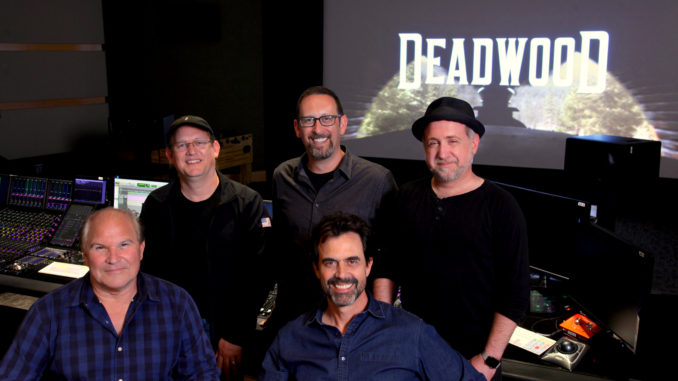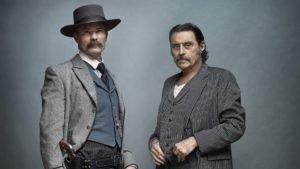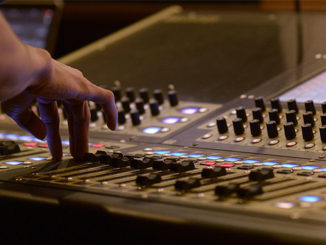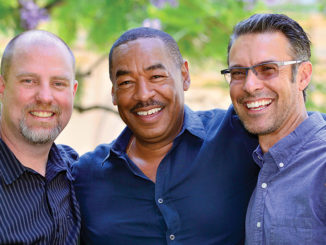
The first sound heard in “Deadwood: The Movie,” is an evocative one: the noise of a steam locomotive barreling across the landscape.
It is an apt start to the feature film of the HBO Western that ran for three seasons from 2004 to 2006 and luxuriated in the texture and ambience of frontier American culture at the close of the 19th century.
The film is set in 1889, 10 years after the conclusion of the series created by David Milch, and the action pivots around South Dakota’s emerging statehood. Directed by Daniel Minahan, the film reunited much of the original cast, headed by Ian McShane as local foul-mouthed power broker Al Swearengen, Timothy Olyphant’s conflicted lawman Seth Bullock and Molly Parker as Alma, a troubled former New York socialite.
Shot at the Melody Ranch Studios in Newhall, Calif., the sound editing is vital to the movie, which transforms ambient noise into storytelling information just as vital as dialogue: the swing of saloon doors, the clink of coins on a poker table, the high-pitched whinny of startled horses.
“Deadwood: The Movie” has received multiple Emmy award nominations for a limited series, movie or special, including for the single camera picture editing for Martin Nicholson, ACE, and Erick Fefferman, and additional editor Cindy Mollo, ACE.
The sound team has also been recognized, and in a conference call, four Emmy-nominated Guild members talked about the particular challenges and excitement of the project. Supervising sound effects editor Daniel Colman, MPSE, and sound supervisor Mandell Winter, MPSE, are nominated for best sound editing. Re-recording mixers John W. Cook II and William Freesh are nominated for outstanding sound mixing, with Geoffrey Patterson, CAS.
CinemaMontage: What kind of research did you undertake to get a feel for the sound of late 19th century South Dakota? What did the Old West sound like?
Daniel Colman: I did a lot of research for this. Since I was not a part of the original show, I went back and watched every single episode and took detailed notes of everything we were hearing. Then we went through the first cut of the show.
We start off with the train, and I wanted to make sure that we were hearing the right train, the right kind of Baldwin Locomotive. Luckily, there is an 1880s Black Hills steam train that goes through Deadwood, so I got recordings of that actual stream whistle so that it is not just random sounds. It is the right sound.
I did a lot of research into what kind of guns every person had. Seth Bullock has a Remington that he carried throughout the show. In real life, he carried a Smith & Wesson. There’s a museum in Deadwood that has a lot of the weapons that a lot of the original people who lived there had, and I could get all of that detail.
Al Swearengen’s clock is prominent in the show, so I found an 1880s American Empire wall clock: little details that nobody would pay attention to but adds to the authenticity of it, or researching things like going to the National Audubon website and figuring out what kind of birds were in the Dakotas during that time.
A lot of it we laid into the sounds we could get from the actual Melody Ranch, where this was shot. During the series, Ben Cook, who was the sound effects editor on the show, recorded a whole bunch of horses going down the road, the wagons, the doors of all the different buildings, so we had all of these great details.
How much did you draw on the library of sounds from the original series?

Colman: A lot. Before I started working on it, Ben restored the last six episodes of his effects work. I went through that and made careful notes and built a library of everything so that we could stay as true to the series as possible. The [movie] was a number a years later, so we changed some things. During the original series, the town was very much being built so there was a lot of hammering and sawing. A lot of it went from being wooden buildings to being stone buildings during that time period, between the show and the movie.
A lot of that stuff we took out, and replaced it with a wall group of people selling things, barkers and stuff like that.
The show last aired 13 years ago, a lifetime as far as technology is concerned. Is the sound of the film different than the sound of the series?
Mandell Winter: We were given the direction from our director, Dan Minahan, to raise the scale [of the sound], since we were making a movie.
Was there part of a conscious decision to differentiate the movie from the show?
Colman: We mixed it quite a bit bigger, and one of the things we did during the mix was finding a middle ground … It started to feel as though it were too different from the series, and then we brought it back down and found that perfect place.
One of the ways they wanted to experiment to make it more theatrical was putting in a lot more music. The final mix has significantly more music than the series does, [although] it still is way under what now we think of a music score where you have to wall-to-wall music. It’s not like that at all. As a sound designer I love that because you can hear so much more detail in all the effects, and all the background voices, than you can in most movies.
What makes the series and now the film so distinctive is the language, almost Shakespearean, baroque and profane and colorful. Especially in the open-air sequences, what kind of work goes into making sure we hear that speech in its purest form?
Winter: It starts with great production recording. Our production mixer captured really great tracks that we were able to edit and de-noise and prep for the stage so that John could mix the dialogue beautifully.
John Cook: The production mixer was Geoffrey Patterson. He was, like Bill Freesch, on the original series. Sometimes part of my job is to rescue production audio and there was not really much to do because Geoff delivered such great stuff. Working with the Shakespearean-style dialogue, for me it was important not to lose syllables. My job was to make sure that everything was as intelligible as possible, working every line and every syllable.
It must be daunting but also exhilarating recreating the sound of a Western—the horses, stagecoaches, the conflict inside a saloon. It seems like a world of unlimited possibilities.
William Freesh: Who doesn’t want to get a chance to work on a Western? They are so organic. Everything is so rich, the sounds of wood and leather and the natural sounds and the ambience. It’s such a great difference from a movie full of music and modern sounds of cars, trains and whatnot. It gives you a chance to creep back in time a little bit.
To those of you who worked on the series, how beneficial was that to this project?
Freesh: I did all three seasons, and it definitely gave me a perspective on how to approach the mix for the movie. Before we started even mixing the series, we had a map of the town showing us where the different locations were in respect to each other, the Main Street with the Gem Saloon, the Chinese alley, the blacksmith area and so forth.
[Ben] Cook had designed a very specific soundscape for each of the locations, whether it was the evening casino gambling at the brothel or the more subdued kind of sounds farther away from town where the Saloon Number 10 was.
What was it like to return to the story after so long away?
Freesh: I always felt like “Deadwood” was one of those once-in-a-lifetime shows you get a chance to work on. We all had such a great time working together. At first, I was kind of surprised by the number of people who returned to show, not just the post side but the production side as well, from grips to all the actors and the whole post crew. Then I realized that everybody probably felt the same way that I do. It was important to be part of this movie and end the series.
Was your collaboration with the director comparable to how he might interact with the DP or the production designer?
Colman: In this case, it was actually very different, and it was by accident that it was different. We started working on the film for a few days and then HBO decided they wanted a re-cut and they pulled the plug for a month. During that time, I knew I was going to have time conflicts with another show a month later.
During the time when they were re-cutting the picture, I built the entire movie sound effects. Only then did I first have a meeting with Dan Minahan when we spotted the show, and then it was just a matter of conforming to his new cut and putting in a few details that he wanted there. A lot of that was experimenting with this idea or that idea. The normal way we work is, we have a conversation before I start cutting anything. This was a different approach. Because we were building off the series, it was not as if I was starting completely from scratch. I knew what the show needed to be.
The movie western is almost an embarrassment of riches. Were there times you felt like you almost had to reign yourself in, so that the ambient sounds are not too pronounced?
Cook II: I think even though all of us on the sound crew are working closely together the whole time, if I am doing my job right and I am tracking the emotion and the storytelling on the dialogue and music side, by the time I am done with pre-dubbing, it should be a pretty good map for all of the great work that Daniel has done with sound effects and Bill is doing with his pre-dub work on ambience to use as a map to fill in the ambience without interfering with the storytelling.
I think that was true with this project. There was a lot of playing with music levels for us to track the emotion in a cinematic way and the way that Dan wanted to, so that was a negotiation as we went. It was fun experimenting with that balance of the ambience and the music with dialogue throughout the whole movie.
We talk about the invisible style of picture editing that tends to work by implication. Sound work feels much different in the way audiences process it, as if we are meant to hear and feel everything.
Winter: I think a lot of what we do works on a subconscious level. It may be affecting the emotion or having the audience look in a certain direction and try to understand this character’s motivation without hitting them over the head and saying, Look here.
A lot of our work is in the details. If you are hearing the bumps in the dialogue, then I am not doing my job right. If you are hearing specific things and thinking, “I hear that,” then the tapestry is not woven tight enough. I think we all work together to stitch together the soundtrack so that the audience just goes for the ride, and they just have something leading them through it.
Colman: From a sound effects perspective, I think the audience pays most attention to sound effects when something is wrong and especially when you are doing a period piece making everything as perfect and authentic as possible makes them not pay attention and they just feel like “That’s the town,” or “That’s what it actually sounds like.” When something is awry, that is when they suddenly listen and they say, “I am not paying attention to the sound anymore, I am paying attention to the sound that is wrong.”
The has two big set pieces featuring a wedding and a funeral. How did you utilize sound to differentiate those two big moments?
Freesh: The scenes are so different, the joys of the wedding, everybody having a great time and then unfortunately [going] to the sadness. With the sound, we were just complementing what the director shot. We were just supportive of that.
Cook II: The a cappella [singing] piece we used was pretty unique and beautiful. They used a temp piece they found on YouTube of a group and I think they went back to that part of the country to record them. I think they were not really experienced musicians. They just had a great rawness, and in that rawness a huge amount of emotion and appropriateness for the scene.
[The producers] talked about licensing the recording straight off of YouTube but we encouraged them since the rest of the movie sounded so great, we should go back and re-record that stuff that recapture the same emotion. They were concerned about whether they would be able to capture that authentic rawness they heard on YouTube. They worked hard all day to re-record that.
In preproduction a director and his cinematographer might watch other film as inspiration for the style or look. Do you do something similar?
Colman: I study all the time. I am constantly listening to films and listening to how they deal with all the little details and making mental notes of what works and what doesn’t. With any kind of period piece, I want to make everything right. You think about the costume designers and the details they go through to make sure the pattern is exactly right and the thread is exactly right; it should be, and often is not, done in sound.
What is your proudest achievement on the movie?
Freesh: I think just being a part of it, and being faithful to the series and to Milch and his overall picture.
Winter: I think I’d second what Bill said. I was an outsider walking into this group of people at Universal and just working with great people was the biggest reward for me.
Colman: I was a huge fan of the show. Going in and to get to work on this was definitely a dream come true.
On a more personal note, one sound I have never thought sounded good [in previous shows] was the sound of the magnesium flash of a period large-format camera. It always just sounded like a poof with no character to it.
It took me three weeks to find a photographer who specializes in period, large-format photography and I convinced him to record a whole bunch of magnesium flashes. You could hear the sizzle of the power burning on the metal. I just love that sound so much. That is the best recording in existence.
What was the greatest challenge you had to overcome during the course of your film.
Cook II: Time is the biggest hurdle on this particular show, especially after the schedule had moved and we had to accommodate that new period. There was a lot to do. We were working on two different stages, working at the same time. Dan was pre-dubbing on one stage and I was pre-dubbing on the other, and we didn’t come together for the first couple weeks.
Colman: On the editorial side, because of work conflicts, we had lost pretty much the whole crew we put together. Mandell and I managed to stay on it. Ben Cook, who was originally hired as supervising sound editor, had to leave to do something else.
Winter: There is never enough time.
Patrick Z. McGavin is a Chicago film critic and cultural journalist. His writing on film appears at RogerEbert.com the review anthology, Magill’s Cinema Annual.




